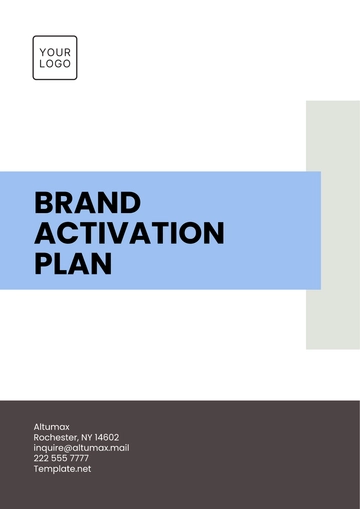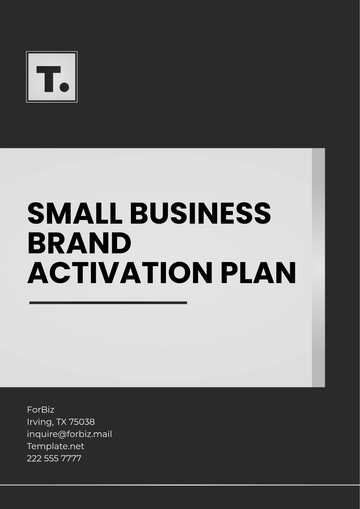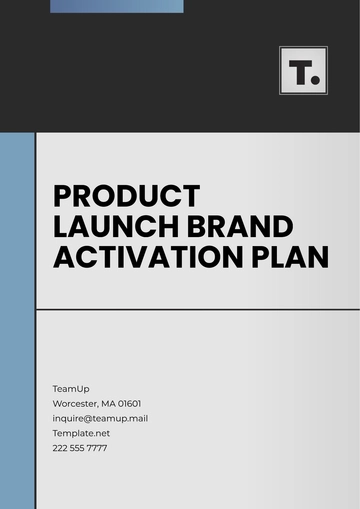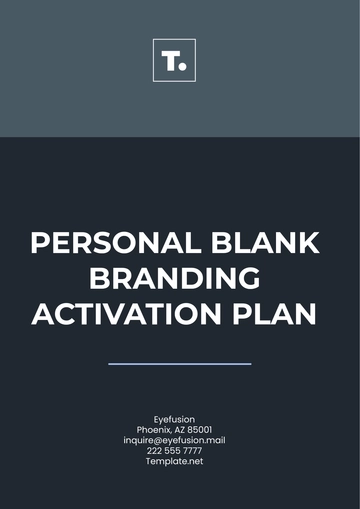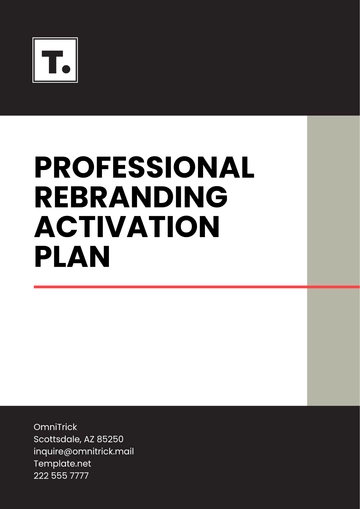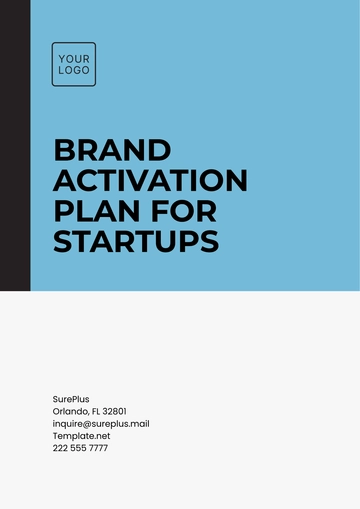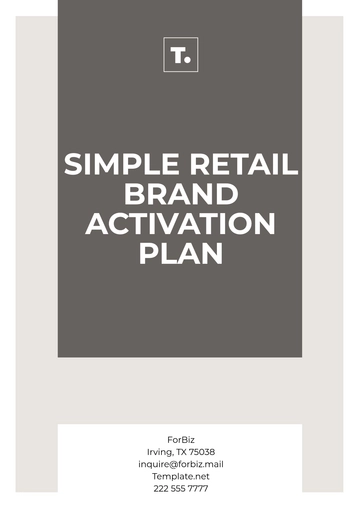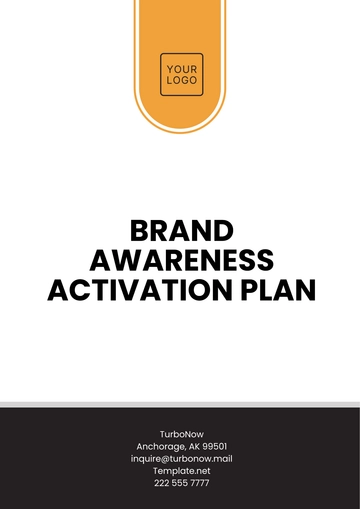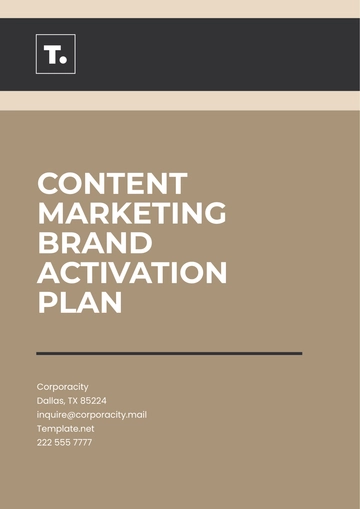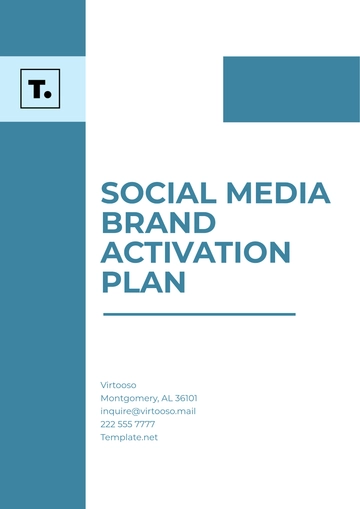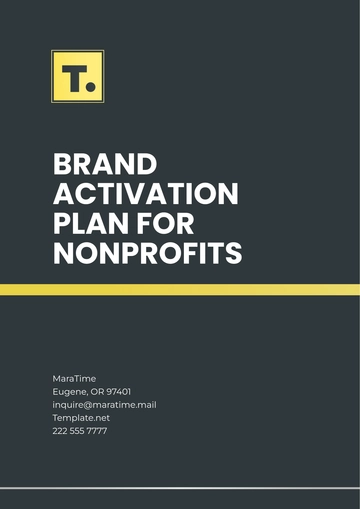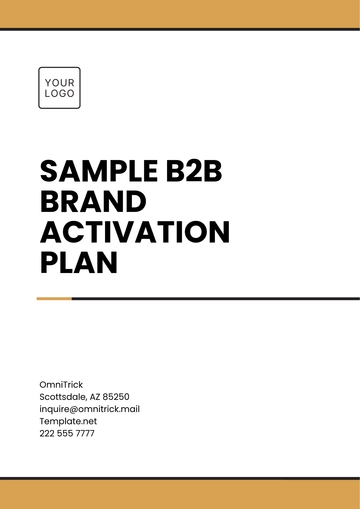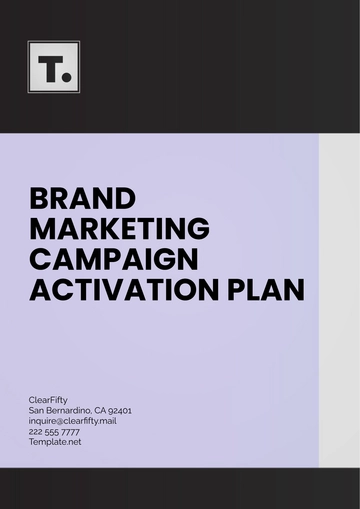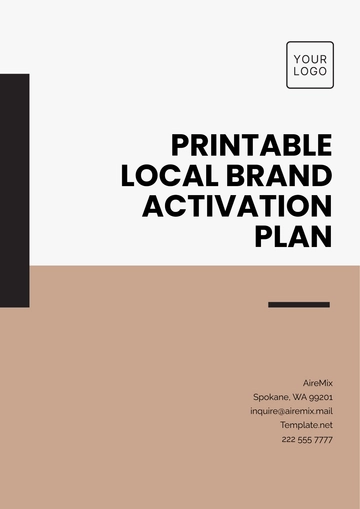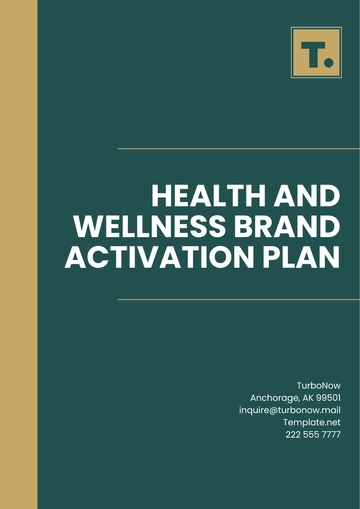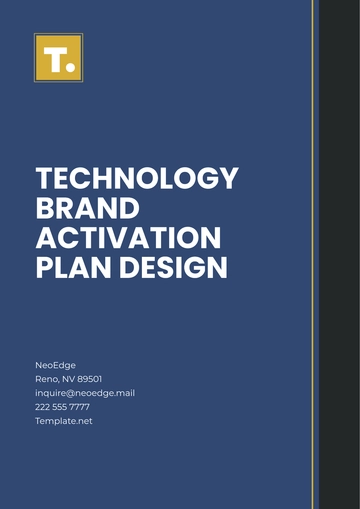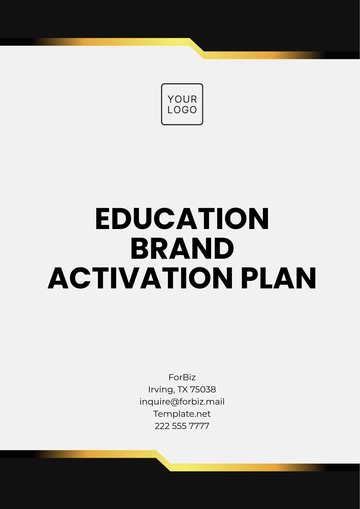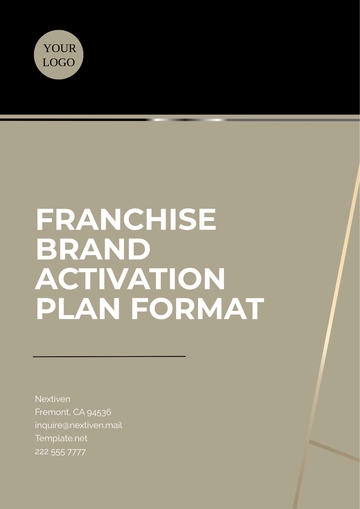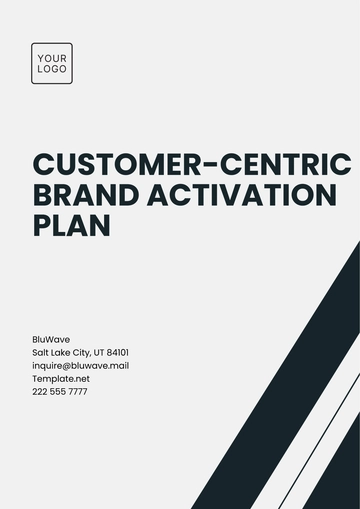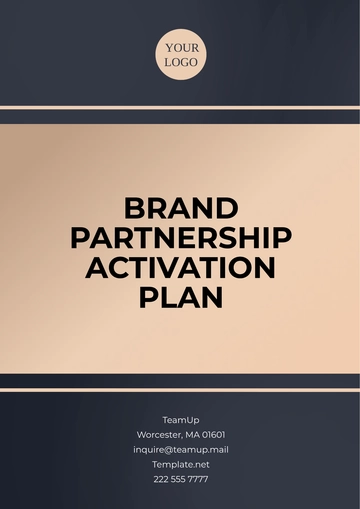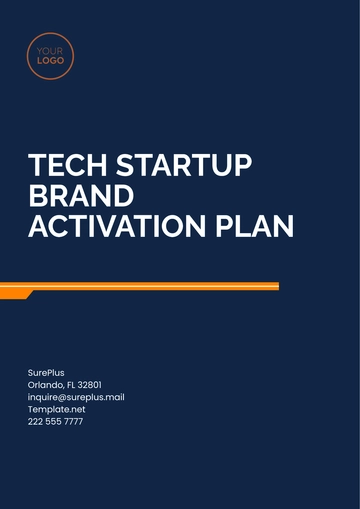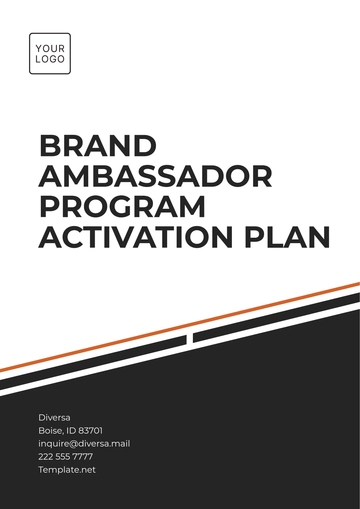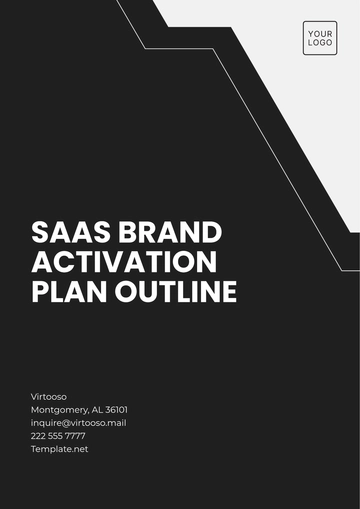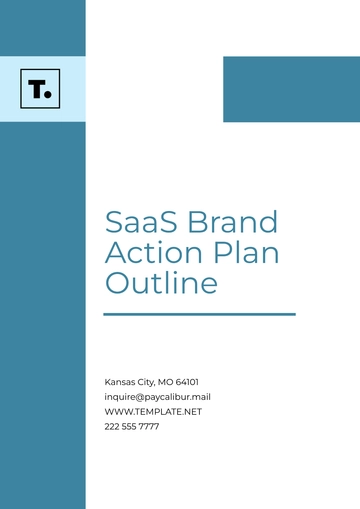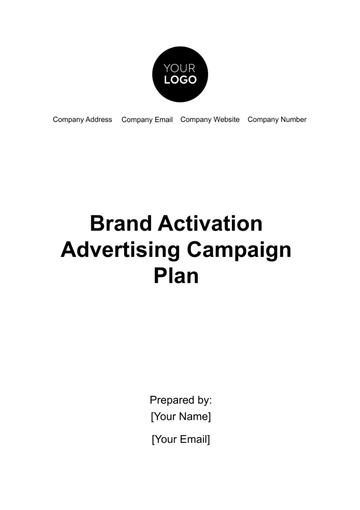Free SaaS Brand Activation Plan Outline

Prepared by: [Your Name]
Company: [Your Company Name]
Date: [Insert Date]
Introduction
This SaaS Brand Activation Plan is designed to establish and enhance the brand's presence in the market, engage its target audience, and drive both user acquisition and retention. With a strategic approach, the plan incorporates key elements such as content marketing, influencer partnerships, and product engagement to solidify the SaaS brand as a trusted and innovative solution in its field.
1. Executive Summary
This activation plan provides a step-by-step approach to building brand awareness and engaging potential customers through targeted campaigns and initiatives. The aim is to position the SaaS product as an essential tool for businesses and users seeking solutions to improve productivity, efficiency, and innovation.
2. Goals and Objectives
Goals
Establish a brand presence in the SaaS market.
Create high levels of user engagement.
Generate leads and conversions through brand awareness campaigns.
Objectives
Increase website traffic by 30% within the first six months.
Acquire 5,000 new users within the first quarter of activation.
Achieve a 20% customer retention rate increase by the end of the first year.
3. Target Audience
Primary Audience
Small to medium-sized businesses looking for productivity-enhancing software.
Marketing and operations teams within larger organizations.
Freelancers, entrepreneurs, and independent professionals.
Secondary Audience
Tech influencers and bloggers in the SaaS and business productivity sectors.
Industry analysts and reviewers of SaaS products.
4. Brand Positioning and Value Proposition
Brand Positioning
Position the SaaS solution as a cost-effective, user-friendly, and scalable tool for companies of all sizes.
Highlight the unique features and benefits that set the SaaS solution apart from competitors, such as customizability, integration capabilities, and customer support.
Value Proposition
"Streamline your operations and boost productivity with our SaaS platform, designed to grow with your business."
5. Key Activation Strategies
A. Product Trials and Demonstrations
Free Trial Offerings: Provide a limited-time free trial for users to experience the platform firsthand.
Interactive Demos: Host live product demos that showcase key features and how they solve pain points.
Onboarding Support: Offer guided onboarding to ensure users are set up for success with the platform.
B. Content Marketing Strategy
Educational Blog Posts: Create blog content that educates the audience about the SaaS industry, trends, and use cases of your product.
Case Studies and Whitepapers: Develop in-depth case studies and downloadable resources highlighting the product’s impact on businesses.
Webinars and Tutorials: Host online events to demonstrate product features and engage with customers in real time.
C. Social Media Marketing
Influencer Collaborations: Partner with relevant influencers in the SaaS and tech space to amplify brand messaging.
User-Generated Content Campaigns: Encourage satisfied customers to share their success stories on social media with branded hashtags.
Engaging with Online Communities: Participate in relevant discussions on platforms such as Reddit, LinkedIn, and Facebook groups.
D. Referral Program
Launch a Referral Program: Offer existing users discounts or rewards for referring new customers to the platform.
Ambassador Program: Identify loyal users who can act as ambassadors to promote the product to their networks.
6. Budget and Resource Allocation
Budget Breakdown
Content Creation & Marketing: $20,000
Product Trials and Onboarding Support: $10,000
Influencer Partnerships and Social Media Campaigns: $15,000
Referral and Ambassador Program: $5,000
Webinars & Event Hosting: $5,000
7. Metrics and KPIs
Key Performance Indicators (KPIs)
Lead Generation: Track the number of sign-ups or demo requests through activation campaigns.
Conversion Rate: Monitor the percentage of trial users converting to paid customers.
Customer Retention: Measure the renewal rate of customers after their trial period ends.
Engagement Metrics: Analyze website traffic, blog views, social media engagement, and influencer mentions.
Measurement Tools
Google Analytics for tracking website traffic and conversions.
HubSpot for CRM and lead tracking.
Hootsuite or Buffer for social media engagement analytics.
8. Timeline and Milestones
Phase 1: Preparation (Month 1–2)
Finalize branding and messaging.
Develop the content calendar and launch content creation.
Onboard influencers and prepare the referral program.
Phase 2: Launch (Month 3–4)
Begin product trials and live demonstrations.
Implement influencer campaigns and user-generated content initiatives.
Host the first set of webinars.
Phase 3: Growth (Months 5–6)
Evaluate the effectiveness of activation campaigns.
Continue social media outreach and refine the referral program based on feedback.
Expand partnerships with industry influencers.
Phase 4: Optimization (Months 7–12)
Optimize paid campaigns and organic reach.
Review customer feedback and improve the user experience.
Refine messaging based on performance metrics.
9. Risks and Mitigation Strategies
Potential Risks
Low engagement with content or trials due to lack of awareness.
Slow conversion rates from free trials to paid customers.
Saturation of influencer promotions leading to diminishing returns.
Mitigation Strategies
Use A/B testing on content and messaging to optimize engagement.
Implement a drip email campaign for nurturing trial users and converting them to paying customers.
Continuously refresh influencer partnerships and explore new platforms for outreach.
10. Conclusion
This SaaS Brand Activation Plan presents a structured approach to introducing and promoting a SaaS product in the market. Through strategic content marketing, user engagement, influencer partnerships, and product trials, the plan is designed to foster growth, improve user acquisition, and increase brand recognition. By executing this plan, the SaaS brand will build lasting relationships with users and establish itself as a leader in the industry.
- 100% Customizable, free editor
- Access 1 Million+ Templates, photo’s & graphics
- Download or share as a template
- Click and replace photos, graphics, text, backgrounds
- Resize, crop, AI write & more
- Access advanced editor
You may also like
- Finance Plan
- Construction Plan
- Sales Plan
- Development Plan
- Career Plan
- Budget Plan
- HR Plan
- Education Plan
- Transition Plan
- Work Plan
- Training Plan
- Communication Plan
- Operation Plan
- Health And Safety Plan
- Strategy Plan
- Professional Development Plan
- Advertising Plan
- Risk Management Plan
- Restaurant Plan
- School Plan
- Nursing Home Patient Care Plan
- Nursing Care Plan
- Plan Event
- Startup Plan
- Social Media Plan
- Staffing Plan
- Annual Plan
- Content Plan
- Payment Plan
- Implementation Plan
- Hotel Plan
- Workout Plan
- Accounting Plan
- Campaign Plan
- Essay Plan
- 30 60 90 Day Plan
- Research Plan
- Recruitment Plan
- 90 Day Plan
- Quarterly Plan
- Emergency Plan
- 5 Year Plan
- Gym Plan
- Personal Plan
- IT and Software Plan
- Treatment Plan
- Real Estate Plan
- Law Firm Plan
- Healthcare Plan
- Improvement Plan
- Media Plan
- 5 Year Business Plan
- Learning Plan
- Marketing Campaign Plan
- Travel Agency Plan
- Cleaning Services Plan
- Interior Design Plan
- Performance Plan
- PR Plan
- Birth Plan
- Life Plan
- SEO Plan
- Disaster Recovery Plan
- Continuity Plan
- Launch Plan
- Legal Plan
- Behavior Plan
- Performance Improvement Plan
- Salon Plan
- Security Plan
- Security Management Plan
- Employee Development Plan
- Quality Plan
- Service Improvement Plan
- Growth Plan
- Incident Response Plan
- Basketball Plan
- Emergency Action Plan
- Product Launch Plan
- Spa Plan
- Employee Training Plan
- Data Analysis Plan
- Employee Action Plan
- Territory Plan
- Audit Plan
- Classroom Plan
- Activity Plan
- Parenting Plan
- Care Plan
- Project Execution Plan
- Exercise Plan
- Internship Plan
- Software Development Plan
- Continuous Improvement Plan
- Leave Plan
- 90 Day Sales Plan
- Advertising Agency Plan
- Employee Transition Plan
- Smart Action Plan
- Workplace Safety Plan
- Behavior Change Plan
- Contingency Plan
- Continuity of Operations Plan
- Health Plan
- Quality Control Plan
- Self Plan
- Sports Development Plan
- Change Management Plan
- Ecommerce Plan
- Personal Financial Plan
- Process Improvement Plan
- 30-60-90 Day Sales Plan
- Crisis Management Plan
- Engagement Plan
- Execution Plan
- Pandemic Plan
- Quality Assurance Plan
- Service Continuity Plan
- Agile Project Plan
- Fundraising Plan
- Job Transition Plan
- Asset Maintenance Plan
- Maintenance Plan
- Software Test Plan
- Staff Training and Development Plan
- 3 Year Plan
- Brand Activation Plan
- Release Plan
- Resource Plan
- Risk Mitigation Plan
- Teacher Plan
- 30 60 90 Day Plan for New Manager
- Food Safety Plan
- Food Truck Plan
- Hiring Plan
- Quality Management Plan
- Wellness Plan
- Behavior Intervention Plan
- Bonus Plan
- Investment Plan
- Maternity Leave Plan
- Pandemic Response Plan
- Succession Planning
- Coaching Plan
- Configuration Management Plan
- Remote Work Plan
- Self Care Plan
- Teaching Plan
- 100-Day Plan
- HACCP Plan
- Student Plan
- Sustainability Plan
- 30 60 90 Day Plan for Interview
- Access Plan
- Site Specific Safety Plan
